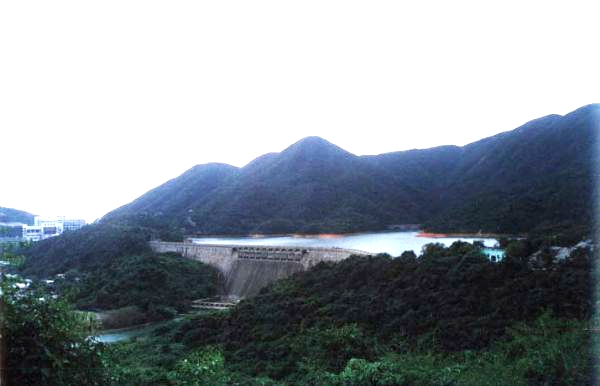| |
A
Counter-Attack
In that charge Lieutenant Charles French was hit twice by a
machine gun fire in the first few minutes of the attack and
died. Company Sergeant Major John Osborn took command and led
the charge which re-took Mount Butler. The Grenadiers inflicted
heavy losses on the Japanese until there were just 30 Grenadiers
left.
Alone, those 30 Grenadiers held the peak for more than three
hours. Then with a flank exposed, and being chopped up by
machine-gun fire, they were forced to withdraw. They fought
their way back down Mount Butler and somehow managed to link up
with the rest of "A" Company.

Tai Tam Resrvoir Today - Photo Courtesy of
Jeff Yam, Hong Kong
The Grenadiers attempted to draw back to
Wong Nei Chong, but the entire Company was surrounded. In the
fighting which ensued Company Sergeant Major Osborn literally
gave up his life to save his men. The six survivors of the two
platoons of "A" Company of the Winnipeg Grenadiers, which had
launched the counter-attack, became prisoners of war. The others
had given their lives in the "Battle of Hong Kong".
"A" Company of The Grenadiers suffered many wounded. They asked
the Japanese if they could take their injured with them. The
Japanese said, "No, we will take care of them." They did. They
shot and bayoneted the wounded to the last man. A war crimes
investigation unit found the remains of the men after WWII, in a
stream bed where they had been slaughtered. Japanese Colonel
Tanaka Ryosabura, whose troops committed the cold-blooded
murders was tried, convicted and executed after the war for his
crimes.
Later that same afternoon, "D" Company of the Winnipeg
Grenadiers, still under the command of Captain Alan Bowman, was
ordered to counter-attack a Japanese stronghold called Mount
Austin which had been captured. Neal Bardal, Adjutant of the
Winnipeg Grenadiers, recounts the story of Captain Bowman:
"Bowman had been involved since December 10th in heavy fighting
on the mainland. He had endured 8 days of incessant artillery
and aerial bombardment, lack of food, lack of sleep, and the
tremendous stress of looking out for his men.
“In the afternoon that the Japanese swarmed ashore, Bowman was
ordered to launch a counter-attack. Bowman was so exhausted that
he was reduced to talking gibberish. He was last seen charging
the Japs with a blazing Tommy-gun. He was never given the credit
for those incredible days of fighting."
Brigadier Lawson's Headquarters Under
Attack
Still later that day, as the Japanese
under the command of Colonel Shoji Toshishga drove onwards to
the South, Brigadier Lawson decided to move his Headquarters to
a new location, but before he did, his headquarters group was
surrounded. The Japanese were firing straight into the shelter
where Lawson was located. A company of the Royal Scots made a
brave attempt to help the Grenadiers break free, but less than a
dozen Scots managed to fight their way through, and it was too
late. Brigadier Lawson reported to "Fortress Headquarters"
that they were "going outside to fight it out with the Japs".
Pistols in hand and accompanied by his
Chief Staff Officer, Col. P. Hennesy and a Royal Rifles
intelligence officer named Arnold Woodside, he ran out the door
towards "Fortress Headquarters". The Japanese cut the
three of them down with machine-gun fire and they died
instantly.

Brigadier
Lawson's Bunker where he died defiantly, December 19, 1941 -
Photo Courtesy of Bill Lake
In Ottawa, another communique from Hong
Kong had advised the Minister of Defense, Hon. J.L. Ralston of
Lawson's death and he made the difficult announcement to the
Canadian public. He had been advised in a situation report "that
Brigadier J.K. Lawson and Senior Staff Officer, Col. P. Hennessy
had been killed by shell fire".
The West Brigade was without a commanding officer until the next
day, December 20th, when Colonel H.B. Rose, a Hong Kong
Volunteer Defense Corps officer, was appointed.
Meanwhile the East Brigade were without any artillery support.
They had lost their light Mobile guns in the withdrawal westward
from Mount Parker, and the situation was getting worse by the
minute. East Brigade and West Brigade were all but separated
when the Japanese cut the island in half on a line running
North/South, as they captured Jardine's Lookout then headed
South towards Repulse Bay. The line which the Japanese occupied
that separated East from West Brigade was just about along the
lines that Maltby had drawn up in his redistribution plan.
This is the 'disaster' that Major Maurice Parker mentions in his
memoirs. The Japanese pincers were rapidly closing around the
defenders.
Rfm. Beebe, Royal Rifles of Canada,
December 20...
"Even though we knew we were outnumbered, we asked no quarter
and gave no ground. On the 20th, we killed 600 Japs and on the
23rd I got mine, machine gun bullets in both legs. Our boys
rallied for a bayonet charge and those Japs who had been able to
push into our position were driven out with heavy loss.”
An Official Japanese Broadcast Recorded by
B.U.P., December 19, 1941
"Japanese reports today said that Hong Kong has been in Japanese
hands since 11:00 AM Friday. The island was covered by a heavy
pall of smoke from fires started by air and artillery
bombardment. Earlier, the Japanese Imperial Headquarters claimed
that Japanese troops had landed at three points and had stormed
a 1,500 foot dominating hill in the center of the island,
despite strong British resistance." The report was true.
Japanese military experts were quoted by newspapers as saying
that the British batteries were designed for long-range defense
and therefore valueless, because the fighting had been at close
quarters. This report was also true.
________________________________________
|

